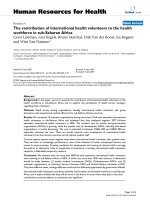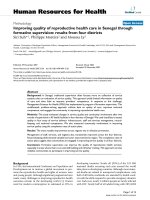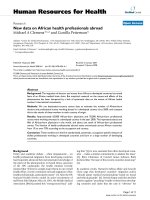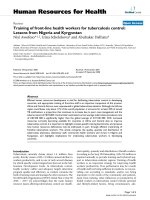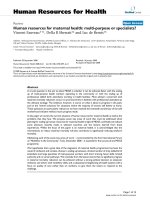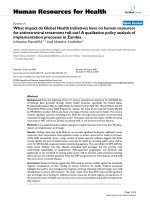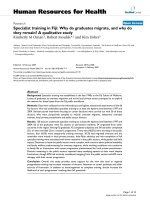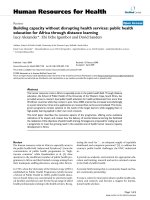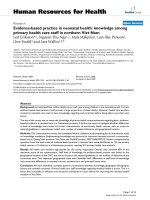báo cáo sinh học:" Evidence-based practice in neonatal health: knowledge among primary health care staff in northern Viet Nam" potx
Bạn đang xem bản rút gọn của tài liệu. Xem và tải ngay bản đầy đủ của tài liệu tại đây (378.41 KB, 10 trang )
BioMed Central
Page 1 of 10
(page number not for citation purposes)
Human Resources for Health
Open Access
Research
Evidence-based practice in neonatal health: knowledge among
primary health care staff in northern Viet Nam
Leif Eriksson*
1
, Nguyen Thu Nga
1,2
, Mats Målqvist
1
, Lars-Åke Persson
1
,
Uwe Ewald
3
and Lars Wallin
1,4,5
Address:
1
International Maternal and Child Health, Department of Women's and Children's Health, Uppsala University, Uppsala, Sweden,
2
Vietnam Sweden Uong Bi General Hospital, Quang Ninh, Viet Nam,
3
Neonatology, Department of Women's and Children's Health, Uppsala
University, Uppsala, Sweden,
4
Department of Neurobiology, Care Sciences and Society, Division of Nursing, Karolinska Institutet, Stockholm,
Sweden and
5
Clinical Research Utilization, Karolinska University Hospital, Stockholm, Sweden
Email: Leif Eriksson* - ; Nguyen Thu Nga - ; Mats Målqvist - ; Lars-
Åke Persson - ; Uwe Ewald - ; Lars Wallin -
* Corresponding author
Abstract
Background: An estimated four million deaths occur each year among children in the neonatal period. Current
evidence-based interventions could prevent a large proportion of these deaths. However, health care workers
involved in neonatal care need to have knowledge regarding such practices before being able to put them into
action.
The aim of this survey was to assess the knowledge of primary health care practitioners regarding basic, evidence-
based procedures in neonatal care in a Vietnamese province. A further aim was to investigate whether differences
in level of knowledge were linked to certain characteristics of community health centres, such as access to
national guidelines in reproductive health care, number of assisted deliveries and geographical location.
Methods: This cross-sectional survey was completed within a baseline study preparing for an intervention study
on knowledge translation (Implementing knowledge into practice for improved neonatal survival: a community-
based trial in Quang Ninh province, Viet Nam, the NeoKIP project, ISRCTN44599712). Sixteen multiple-choice
questions from five basic areas of evidence-based practice in neonatal care were distributed to 155 community
health centres in 12 districts in a Vietnamese province, reaching 412 primary health care workers.
Results: All health care workers approached for the survey responded. Overall, they achieved 60% of the
maximum score of the questionnaire. Staff level of knowledge on evidence-based practice was linked to the
geographical location of the CHC, but not to access to the national guidelines or the number of deliveries at the
community level. Two separated geographical areas were identified with differences in staff level of knowledge
and concurrent differences in neonatal survival, antenatal care and postnatal home visits.
Conclusion: We have identified a complex pattern of associations between knowledge, geography, demographic
factors and neonatal outcomes. Primary health care staff knowledge regarding neonatal health is scarce. This is a
factor that is possible to influence and should be considered in future efforts for improving the neonatal health
situation in Viet Nam.
Published: 24 April 2009
Human Resources for Health 2009, 7:36 doi:10.1186/1478-4491-7-36
Received: 4 March 2008
Accepted: 24 April 2009
This article is available from: />© 2009 Eriksson et al; licensee BioMed Central Ltd.
This is an Open Access article distributed under the terms of the Creative Commons Attribution License ( />),
which permits unrestricted use, distribution, and reproduction in any medium, provided the original work is properly cited.
Human Resources for Health 2009, 7:36 />Page 2 of 10
(page number not for citation purposes)
Background
The former executive director of UNICEF, James Grant,
said: "The most urgent task before us is to get medical and
health knowledge to those most in need of that knowl-
edge. Of the approximately 50 million people who were
dying each year in the late 1980s, fully two thirds could
have been saved through the application of that knowl-
edge" [1]. Many years after Grant's statement, the use of
appropriate knowledge remains a global problem, partic-
ularly in the area of child health care. Every year almost 10
million children die in the world [2], of whom around
four million die during the neonatal period [3]. This trag-
edy continues to unfold despite the existence of cheap,
evidence-based interventions that could prevent a large
proportion of these deaths [4].
Evidence-based practice (EBP) is a term increasingly used
to describe the application of empirically acquired knowl-
edge in practice [5,6]. In the neonatal period more than
70% of the current deaths could be prevented through evi-
dence-based procedures (e.g. by exclusive breastfeeding
and hypothermia management) [7]. However, health care
workers involved in neonatal care need to have adequate
knowledge about the different procedures before they can
implement and use them. Educational programmes tar-
geting health care staff in developing contexts have shown
improvements in both staff knowledge and health care
outcomes [8,9]. Thus, a primary issue is whether staff has
the required knowledge or not. Understanding the level of
knowledge is of interest for deciding what implementa-
tion strategy might be effective. Unfortunately, effective
and sustainable implementation of knowledge into prac-
tice is not a trivial task, and only a few studies have evalu-
ated strategies for knowledge translation in low-income
countries [10-12].
Staff knowledge regarding evidence-based practice is key,
but also a number of contextual factors are highly influen-
tial for a well-functioning health care system, such as ade-
quate geographical coverage of health care, sufficiency of
material resources (e.g. equipment and drugs) and a cer-
tain level of activity (e.g. number of assisted deliveries) at
the health care units. Although the impact of contextual
factors in relation to knowledge translation has been
given a great deal of attention over the years [13,14], this
has primarily been from the perspective of the local work
context (e.g. leadership and workplace culture). Factors
such as geographical location of health care units [15,16]
and level of activity [17] have received less attention in
relation to knowledge translation.
Viet Nam has achieved substantial improvements in child
and infant survival, reporting a level of infant mortality
corresponding to middle-income countries [18]. How-
ever, neonatal mortality has remained unchanged over
the past three decades, currently constituting nearly three
quarters of all infant deaths [19]. In 2003, the Ministry of
Health in Viet Nam adopted a groundbreaking initiative
to improve neonatal health care by launching practice
guidelines for reproductive health care (here called the
National Guidelines) [20]. These guidelines were dissem-
inated to all public health care units providing antenatal,
intrapartum and postnatal care, but were not accompa-
nied by specific implementation activities.
In Quang Ninh province, our research group has set up
the Neonatal Knowledge Into Practice project (NeoKIP,
ISRCTN44599712). NeoKIP entails collaboration
between Uppsala University in Sweden, the Ministry of
Health in Viet Nam and the Viet Nam-Sweden hospital in
Uong Bi, Viet Nam. The aim of NeoKIP is to evaluate facil-
itation; a knowledge translation intervention that we
hypothesize will speed up identification of local health
care-related problems at community level, increase pri-
mary health care staff knowledge and use of evidence-
based knowledge and subsequently achieve improvement
of neonatal outcomes.
In 2006, we performed a baseline study that identified an
overall neonatal mortality rate (NMR) of 16 deaths per
1000 live births, with districts within the province ranging
in NMR from 10 to 45 per 1000 [21]. The higher rates
were noted in remote and mountainous districts, which
are known to have a higher prevalence of poverty and peo-
ple belonging to ethnic minority groups [22]. The exist-
ence of inequities in child survival is a well-known
problem throughout the world and one on which more
studies are needed to assess specific approaches to over-
come these inequities [23]. Knowledge regarding evi-
dence-based practice and use of this knowledge are central
components for changing the severe situation. In the
NeoKIP project, assessing knowledge will be helpful for
planning and evaluating the coming intervention.
The aim of this survey was to assess the knowledge of pri-
mary health care practitioners regarding basic, evidence-
based procedures in the neonatal care field in a Vietnam-
ese province. Further aims were to assess the availability of
material resources at the community health centres
(CHCs) and to investigate whether differences in knowl-
edge level were linked to (CHCs): (1) access to National
Guidelines, (2) number of assisted deliveries and (3) geo-
graphical location.
Methods
Setting
The Quang Ninh province in Viet Nam is situated 120 km
east of the Vietnamese capital, Hanoi, along the coast in
the north-eastern corner of Viet Nam bordering China.
Quang Ninh has approximately one million inhabitants
Human Resources for Health 2009, 7:36 />Page 3 of 10
(page number not for citation purposes)
living in an area of 5900 km
2
. The province is a mixture of
urban, rural and mountainous settings. Coal mining is the
most important industry, together with a rapidly growing
tourism sector. More than 80% of the population belongs
to the Kinh ethnic group, while most of the remaining
individuals belong to five ethnic minority groups.
In Quang Ninh there are 14 districts that include 184
communities. Eighteen hospitals serve the province, of
which one provincial hospital and one regional hospital
are at tertiary level. In each community there is at least one
CHC responsible for primary health care. The CHCs pro-
vide antenatal care (ANC), assistance in uncomplicated
deliveries and newborn care. The CHCs are staffed by phy-
sicians, midwives, assistant doctors and nurses.
Study population and data collection
Information on health care resources (equipment and
drugs), number of ANC visits among pregnant women,
postnatal home visits by a CHC staff, number of deliveries
and neonatal deaths were collected from all 14 districts.
More details on the data collection on live births and neo-
natal deaths are published elsewhere [21,24]. Because of
logistics, the knowledge survey was not conducted in two
of the districts. Thus, 12 districts with 155 CHCs partici-
pated in the knowledge survey. In these districts, 657
health care workers were employed. Doctors, assistant
doctors, midwives and nurses involved in deliveries and
newborn care at the CHCs were targeted for the knowl-
edge survey. The health workers on duty at the CHCs at
the time of data collection in the NeoKIP's baseline study
(n = 412) were asked to participate.
A questionnaire for assessing staff knowledge was devel-
oped by the research team. It consisted of 16 multiple-
choice questions (Additional file 1) covering basic aspects
of EBP in neonatal care. The following five areas were
included in the knowledge survey: breastfeeding, immedi-
ate postnatal care, infection management, low birth
weight management and postnatal home visits. The
choice of topics was based on EBP as described in the
National Guidelines [20] and in World Health Organiza-
tion (WHO) recommendations on newborn health care
[25]. The selection of questions under each topic was
based on their relevance for neonatal survival but also on
specific issues that we found had shortcomings in the
study area when discussing with practitioners during the
baseline study. The questionnaire was pilot-tested by
nurses in Sweden and CHC staff in Viet Nam and revised
accordingly.
Fifteen full-time project employees collected data from
April to June 2006 for the NeoKIP baseline. At each CHC,
a data collector handed out the questionnaire to survey
participants, who responded individually without access
to any information sources. Whether a CHC or a hospital
had access to certain equipment, drugs and the National
Guidelines was determined through a visual audit by a
data collector using a checklist with 19 items. At CHCs
and hospitals, data collectors met with health care staff
(obstetric and paediatric department at hospitals) and
checked registers for information about the facility and its
health care statistics.
A Geographic Information System (GIS) was set up to
map the location of the health care facilities. Geographical
coordinates were collected using a GPS (Garmin GPS 60).
Data were managed in Mapsource (version 6.0; Garmin
International Inc., Olathe, Kansas, United States of Amer-
ica) and ArcGIS (version 9; ESRI, Redlands, California,
United States of America).
Data analysis
A maximum of 48 points could be obtained in the knowl-
edge survey. Each of the 16 questions could generate three
points; for a maximum score, the respondent had to fill in
the correct alternative(s) required for each question. A
scoring system was developed for calculation of points
that included reductions for incorrectly marked alterna-
tives; a question could not generate less than zero points,
however. The questionnaire responses were entered and
analysed in SPSS (version 14.0; SPSS Inc, Chicago, Illi-
nois, United States of America). For statistical analysis,
independent sample t-test, one-way ANOVA and χ
2
-tests
were used. The results of each question are presented as
percentages of the total number of potential points. The
survey results were compared with the number of deliver-
ies for 2005 at each CHC. For this purpose, the health cen-
tres were sorted into three arbitrary groups: 0, 1–24 and ≥
25 deliveries. For determining distances between districts
and the two hospitals at tertiary level, ArcGIS 9 was used;
the existing road network was not considered.
Ethical considerations
The Ministry of Health in Viet Nam, the Provincial Health
Bureau in Quang Ninh and the Research Ethics Commit-
tee at Uppsala University, Sweden, approved the study.
Participation in the survey was voluntary. The respond-
ents were informed about the purpose of the survey and
gave their consent to participate. Data have been handled
with confidentiality.
Results
Data collection was performed in all (n = 205) health care
units (Fig. 1) providing neonatal care in Quang Ninh
province. At tertiary level there were two hospitals and at
district level 16 hospitals. The community level had 779
health care staff working in the 187 CHCs, including at
least one midwife or one assistant doctor responsible for
neonatal care at each CHC. The findings of the visual
Human Resources for Health 2009, 7:36 />Page 4 of 10
(page number not for citation purposes)
audit of 19 items for neonatal care revealed that most hos-
pitals were well-equipped, whereas the CHCs generally
were lacking in equipment and drugs for safe delivery,
temperature control and neonatal resuscitation (Table 1).
Knowledge survey
The questionnaire was completed by all (n = 412) primary
health care workers on duty at the time of the knowledge
survey, which was 63% (412/657) of the total number of
staff in the 12 participating districts. Among the respond-
ents, 8% (33/412) were doctors, 37% (151/412) assistant
doctors, 24% (98/412) midwives and 31% (130/412)
nurses. The mean age of the respondents was 37 years;
77% (316/412) were female and 80% (331/412)
belonged to the Kinh ethnic group. In total, survey partic-
ipants achieved 60% of the potential points (11 817
points out of 19 776) (Fig. 2), resulting in a mean score of
28.7 (SD ± 6.1) (11 817 points/412 participants). Individ-
ual results ranged from 3 to 44, and mean scores at the
district level varied from 26.7 to 31.5. Midwives (30.4),
medical doctors (29.2), nurses (28.7) and assistant doc-
tors (27.4) differed in mean scores (p < 0.01).
The availability of the National Guidelines was similar at
CHCs and hospitals (Table 1). Among the 155 CHCs par-
ticipating in the knowledge survey, 74% had a copy of the
National Guidelines. There was a similar mean score in
the knowledge survey among staff having access to the
National Guidelines at their CHC (28.7) and those not
having such access (28.6), (p = 0.96). During 2005, 32%
(131/412) of the knowledge survey respondents worked
at a CHC where staff had not assisted in any deliveries,
49% (202/412) worked at a CHC where staff had assisted
in 1 to 24 deliveries and 19% (79/412) worked at a CHC
where the staff assisted in 25 to 92 deliveries. There was
no association between the staff's level of knowledge and
the number of deliveries at the corresponding CHC (p =
0.44).
Based on the results from the knowledge survey, the 12
districts were divided into two groups (the districts with
the six highest and six lowest mean scores), resulting in
two distinct geographical areas, designated here as the
northeast districts (NED) and the southwest districts
(SWD) (Fig. 1). NED consisted of 68 CHCs where staff
had a mean score of 27.1 on the survey, while staff in the
87 CHCs in SWD achieved a mean score of 29.9 (p <
Map over survey areaFigure 1
Map over survey area. Map over Quang Ninh province in northern Viet Nam indicating the location of hospitals and com-
munity health centres. Knowledge survey results indicated two areas of clustered districts: the northeast districts and the
southwest districts.
Human Resources for Health 2009, 7:36 />Page 5 of 10
(page number not for citation purposes)
Table 1: Availability of equipment and drugs at all hospitals and all community health centres in Quang Ninh province, Viet Nam
Items 18 Hospitals % (n) 187 CHCs % (n)
Guidelines
The National Guidelines
a
67 (12) 70 (131)
Hygiene and infections
Soap 100 (18) 94 (175)
Clean gloves 100 (18) 97 (181)
Clean water 100 (18) 81 (151)
1
Alcohol for disinfection 94 (17) 95 (178)
Iodine for disinfection 100 (18) 92 (172)
Antibiotics 100 (18) 99 (185)
Safe delivery
Foetus stethoscope 94 (17) 99 (185)
Forceps 44 (8) 2 (3)
1
Vacuum extraction equipment 28 (5) 1 (2)
1
Vitamin K
1
67 (12) 11 (21)
1
Temperature control
Radiant heater 89 (16) 11 (21)
1
Towels for newborn 78 (14) 38 (71)
1
Thermometer 100 (18) 99 (185)
Resuscitation
Face mask and ambo for newborns 89 (16) 10 (18)
1
Face mask and ambo for adults 50 (9) 22 (41)
1
Manual suction 17 (3) 16 (30)
Suction machine 94 (17) 76 (143)
Tube for suction machine 94 (17) 49 (92)
1
a
Guidelines of reproductive health (2003) by the Ministry of Health in Viet Nam
1
Difference (p < 0.05) in availability of an item compared with hospitals as derived from
the χ
2
test.
Human Resources for Health 2009, 7:36 />Page 6 of 10
(page number not for citation purposes)
0.01). This distinct geographical division led us to analyse
whether the use of health care services, neonatal death
and other factors related to neonatal health also differed
between the two areas. The two areas were different in all
assessed health care outcomes. The NED had fewer preg-
nant women who attended three or more ANC visits,
fewer families receiving a postnatal home visit, higher
NMR and lower accessibility of National Guidelines than
the CHCs in the SWD (Table 2). The two tertiary level hos-
pitals in the province were both situated in the SWD (Fig.
1). Patients and health care personnel in the NED were,
on average, three times farther from the tertiary hospitals
than patients and personnel in the SWD (Table 2).
Knowledge survey resultsFigure 2
Knowledge survey results. Results of the knowledge survey among primary health care staff on five topics of neonatal
health care (n = 412).
0
10
20
30
40
50
60
70
80
90
100
12345678910111213141516
Breastfeeding Immediate
postnatal care
Infec tion
management
Low birth
weight
Home visits Total
Five topics on neonatal care
% of achieved score
Table 2: Characteristics of the northeast districts (NED) and the southwest districts (SWD) of Quang Ninh province, Viet Nam, 2005
Variable NED SWD P-value
Average distance to regional hospital (kilometres) 95 31 <0.01
1
Average distance to provincial hospital (kilometres) 75 24 <0.01
1
Neonatal mortality rate
a
21.9 14.2 <0.01
2
Percentage of pregnant women with at least three antenatal care visits 45.6 70.6 <0.01
2
Percentage of live births receiving a postnatal home visit 48.5 56.7 <0.01
2
Percentage of community health centres having the National Guidelines
b
64.7 79.3 <0.05
2
a
Number of deaths during the first 28 days of life per 1000 live births
b
Guidelines of reproductive health (2003) by the Ministry of Health in Viet Nam
1
P-value derived from independent sample t-test comparing NED and SWD
2
P-value derived from the χ
2
test comparing the NED and the SWD
Human Resources for Health 2009, 7:36 />Page 7 of 10
(page number not for citation purposes)
Discussion
Only 60% of the potential points in the knowledge survey
were achieved, indicating that primary health care staff in
the current province appears to have deficient knowledge
regarding basic, evidence-based neonatal care. Geograph-
ical location was identified as a factor linked to staff
knowledge on EBP. The level of knowledge was not asso-
ciated with access to the National Guidelines or the vol-
ume of deliveries at community level, however.
By targeting the primary health care practitioners on duty
at the time of data collection in the 12 districts, an accept-
able coverage was reached (i.e. 63% of all staff individu-
als). The survey questions were based on
recommendations in general guidelines [20,25] and fur-
ther supported by the findings in a recently published sys-
tematic review of community-based interventions for
perinatal health [26]. These sources emphasize the impor-
tance of the five neonatal topics targeted in our knowledge
survey. The questionnaire was not complete in its cover-
age of issues within the five topics, but sufficient to pro-
vide an indication of the level of neonatal knowledge
among primary health care staff. We therefore consider
the present questionnaire to be a valid tool for measuring
basic knowledge on EBP. Pilot tests of the survey ques-
tions further strengthened their validity. The basic charac-
ter of the questions made it reasonable to expect that staff
should be able to answer without help from books or
guidelines. We chose to use multiple-choice questions
because it was a feasible way to assess several areas of neo-
natal health. This knowledge assessment approach was
also familiar to the respondents. Because we used several
multiple-choice questions and a mix of single and multi-
ple correct alternatives, the chance of guessing the correct
answers was minimal [27]. However, there are limitations
with this method that need to be considered when inter-
preting the result [28]. Most of the literature recommends
constructing multiple-choice questions with only one cor-
rect answer [29]; still, the model we used is considered
adequate when using a scoring system adapted to multi-
ple answers [27]. We chose to give the same weight to all
the survey questions (and topics). We also believe that the
external validity is acceptable, since findings could reflect
the situation in many other provinces in Viet Nam. The
country has a uniform health care policy and structure,
and even though Quang Ninh is a rather rich province it
can be considered representative in terms of geography
and demography [22]. Regarding the two districts not
included in the survey, one district was similar in charac-
teristics to the districts in the NED and the other similar in
characteristics to the districts in the SWD. Including these
districts in the survey would most likely not have changed
the overall outcome. A weakness of the NeoKIP baseline
study was the lack of socioeconomic mapping of the pop-
ulation, such as prevalence of poverty and ethnic minori-
ties. We tried to collect data on socioeconomic factors
from all the districts, but the information was incomplete
and therefore not presented here. To get a deeper under-
standing of staff knowledge and the processes of knowl-
edge translation prior to the planned intervention, focus
group discussions were conducted with primary health
care staff from some of the districts included in the survey.
The findings will be published elsewhere.
Knowledge translation interventions are, too often,
implemented without proper examination of the situa-
tion before and during the intervention [11]. Assessing
the level of neonatal knowledge in this survey has helped
us to understand if practitioners' awareness of current
knowledge is an issue that needs to be addressed in the
coming intervention. The staff performed well on some
questions, but the overall findings must be judged as rel-
atively poor, as the questions were limited to a basic level.
The poor results on the questions about umbilical cord
management indicate that CHCs lack a common strategy,
despite concordant recommendations for cord care in the
literature [20,25]. Furthermore, the respondents had
higher scores on questions about initiating breastfeeding
than duration of breastfeeding. This corresponds to how
women in a previous study in Viet Nam responded to
questions about breastfeeding [30] and might indicate a
general lack of knowledge among health care workers on
WHO's recommendations about duration of breastfeed-
ing [31]. Another area assessed in the knowledge survey
was immediate postnatal care. The results clearly demon-
strate a lack of knowledge on the particular questions on
this topic. This finding could be due to the suboptimal
working conditions of the primary health care staff in
comparison to the situation for hospital staff. For exam-
ple, the availability of basic delivery equipment, such as
mask and ambo, radiant heater, towels and Vitamin K
1
,
were considerably lower at CHCs than in hospitals. Lack
of resources can result in negative health care conse-
quences. A recent study from Viet Nam reports vitamin K
deficiency as a major problem in the region around Hanoi
[32], a problem that is preventable by increased knowl-
edge and use of Vitamin K prophylaxis.
There was no difference in knowledge between staff at
CHCs with access to the National Guidelines and staff at
CHCs lacking the guidelines. Despite availability of guide-
lines in three out of four CHCs, the recommendations do
not seem to be fully known by the health care workers
who participated in this study. This finding, which is con-
sistent with previous research [33,34], suggests that access
alone to the National Guidelines does not imply
enhanced knowledge, indicating that passive dissemina-
tion of guidelines has limited impact. Additional methods
reinforcing the implementation of these guidelines
appear to be necessary [35,36]. There is a range of meth-
Human Resources for Health 2009, 7:36 />Page 8 of 10
(page number not for citation purposes)
ods for active implementation of guidelines, including
reminders, opinion leaders, interactive small group meet-
ings, audit and feedback [35,37,38]. These methods are all
suggested to be effective, but the circumstances under
which they work best remain to be further evaluated.
Intervention studies in the knowledge translation field are
particularly required in developing countries [39]. The
global need to advance this field of knowledge is great, as
is the potential for clinical improvements in developing
settings.
In addition to adequate knowledge and resources, the
health care staff needs to have a certain level of clinical
activity to be able to maintain competence and skills. For
example, it is assumed that having too few deliveries in a
health care institution results in difficulties in maintain-
ing high standard delivery care [17]. Yet, in the current
study no association was found between level of knowl-
edge and the number of assisted deliveries at the commu-
nity level. Most likely, the overall delivery activity was too
low to identify any association.
Staff level of knowledge was associated with the geograph-
ical location of the CHCs, where the participating districts
were clearly clustered into two distinct areas, with staff
working in the north-east scoring lower than staff in the
south-west part of the province. Unfortunately we lack
detailed socioeconomic information at the district and
community level, but the two geographical areas most
likely differ in such demographics [18,22]. The NED,
which is a more pronouncedly mountainous and rural
area, can be assumed to have a larger proportion of poor
people and inhabitants belonging to an ethnic minority
group than the SWD. It is known that poorer segments of
a population benefit less from public spending in health
[40] and inequity is a complex and common problem
within many developing countries [23]. The distribution
of knowledge regarding neonatal practices in Quang Ninh
province might be explained using Rogers's theory on the
diffusion of innovations [41] and the inverse equity
hypothesis postulated by Victora and colleagues [42].
New (health care) interventions first tend to be adopted
by a subset of the population [41,43] and the inhabitants
belonging to groups with higher socioeconomic status are
initially reached more often, resulting in an increased gap
between socioeconomic groups [42]. This gap, however,
tends to narrow over time when the demands in the
higher socioeconomic groups decrease.
Another potential causative factor to account for the asso-
ciation between knowledge and geographical location is
the allocation of hospitals. The health care facilities at the
primary and secondary level were evenly distributed, but
the two tertiary hospitals were located in the south. In
developing countries where infrastructure often is insuffi-
cient, factors such as long distance to hospitals and
remote location are known to have implications for mor-
tality [44]. People in the NED were, on average, three
times farther from these hospitals than people in the
SWD. Much of the health care expertise is located in the
large hospitals, which are also centres for training and
education. Rodgers et al. [45] emphasize opportunities for
continuing education as a crucial factor for research utili-
zation among health care staff, and a multi-country study
by Victora and colleagues [46] showed lower uptake of a
health intervention in poorer and more rural areas. Fur-
thermore, Olade [16] describes several contextual barriers
for research utilization among rural nurses, some of
which are isolation and lack of knowledgeable profes-
sional colleagues. There are reasons to believe that a long
distance between CHCs and tertiary level hospitals could
be a barrier, both to knowledge translation and quality of
care. Many contextual factors are considered to be linked
to research utilization, but most studies have investigated
only factors within organizations (e.g. working climate
and access to research resources) [13,14]. In accordance
with Andrews and Moon [15], we believe that geographi-
cal location of health care units is a contextual factor that
deserves more attention. Looking upon staff level of
knowledge through a geographical lens has helped us
understand where certain efforts are primarily needed in
the future.
The two geographical areas that had different levels of
knowledge among health care staff were also found to dif-
fer in quality of care (ANC and postnatal home visits) and
neonatal survival. Generally there was uncertainty among
survey respondents as to why, when and by whom a home
visit should be conducted, even though this is clearly
described in the National Guidelines [20] and stated in
other literature [7,47,48]. More than half of all families
with a newborn child did not receive a home visit and, in
accordance with the knowledge survey, staff members
working in the NED were conducting fewer home visits
than staff in the SWD. If home visits are neglected, there is
an increased risk that severe infections that might arise a
few days after birth are not detected. Such infections, in
most cases, will need the attention of professional health
care personnel [3,7], and the absence of home visits might
therefore have severe consequences for the families. This
is especially true for those families with a woman deliver-
ing at home, since a home visit of a midwife could be the
family's only link to the health care system. Moreover,
there was a 50% higher NMR in the NED than in the SWD,
which strongly points to an inequity in neonatal survival,
probably primarily because of differences in socioeco-
nomic factors [23] and distance to health facilities. The
difference in knowledge among health care staff might
also contribute to the difference in neonatal mortality: the
area with the lowest level of knowledge had the highest
Human Resources for Health 2009, 7:36 />Page 9 of 10
(page number not for citation purposes)
NMR. Evidently the difference in knowledge alone cannot
explain the difference in NMR. Rather, this identified link
between knowledge and neonatal mortality might pro-
vide one ingredient in a complex picture of potentially
casual associations. Globally, the underuse of EBP is
described as a major reason for high neonatal mortality
[7]. Further, recent studies demonstrate that increased use
of EBP resulted in improved neonatal care and reduced
neonatal mortality [10,12]. Whether staff level of knowl-
edge is a contributing cause to the inequities in quality of
care and neonatal survival or an effect of differences in
socioeconomic factors is open for further investigation
and discussion. Tugwell and co-workers suggest an evi-
dence-based framework for equity-oriented knowledge
translation to incorporate issues on health equity [49].
This framework underlines the importance of identifying
and prioritizing barriers as a base for choosing effective
knowledge translation strategies for individuals belonging
to different socioeconomic groups.
Conclusion
Overall, the findings point to a rather low level of knowl-
edge in neonatal care among the primary health care
workers in a Vietnamese province. We also found that
geographical location of a community health centre was
associated with the level of knowledge. Two distinct geo-
graphical areas not only differed in staff knowledge but
also proved to have major inequities in neonatal mortality
and quality of neonatal care. These inequities were prob-
ably linked to socioeconomic differences. Although the
findings indicate a complex web of associations involving
knowledge, geography, demographic factors and neonatal
outcomes, we believe staff knowledge and use of knowl-
edge to be important and feasible factors to work on for
improving the neonatal health situation in Viet Nam.
Competing interests
The authors declare that they have no competing interests.
Authors' contributions
LE and LW designed the study, with assistance of NTN,
MM, LÅP and UE. NTN supervised data collection. LE
cleaned data and performed the statistical analyses
together with LW. LE was lead author in writing the man-
uscript, primarily assisted by LW. All authors have read
and approved the final manuscript.
Additional material
Acknowledgements
This study was partly financed by Sida/SAREC, Sweden. We want to thank
Emmeli Frölund and Johan Wennerdal for entering survey data and the
health care staff in Quang Ninh province for participating in the survey.
References
1. Grant J: Opening session, world summit on medical educa-
tion, Edinburgh 8–12 August, 1993. Medical Education 1994,
28:11.
2. UNICEF: State of the World's Children 2008. 2007 [http://
www.unicef.org/sowc08/docs/sowc08.pdf]. New York: UNICEF
3. Lawn JE, Cousens S, Zupan J: 4 million neonatal deaths: When?
Where? Why? Lancet 2005, 365:891-900.
4. Mason E: Child survival: time to match commitments with
action. Lancet 2005, 365:1286-1288.
5. McKibbon KA: Evidence-based practice. Bull Med Libr Assoc 1998,
86:396-401.
6. Rycroft-Malone J, Seers K, Titchen A, Harvey G, Kitson A, McCor-
mack B: What counts as evidence in evidence-based practice?
J Adv Nurs 2004, 47:81-90.
7. Darmstadt GL, Bhutta ZA, Cousens S, Adam T, Walker N, de Bernis
L: Evidence-based, cost-effective interventions: how many
newborn babies can we save? Lancet 2005, 365:977-988.
8. Allen CW, Jeffery H: Implementation and evaluation of a neo-
natal educational program in rural Nepal. J Trop Pediatr 2006,
52:218-222.
9. McClure EM, Carlo WA, Wright LL, Chomba E, Uxa F, Lincetto O,
Bann C: Evaluation of the educational impact of the WHO
Essential Newborn Care course in Zambia. Acta Paediatr 2007,
96:1135-1138.
10. Bang AT, Bang RA, Reddy HM: Home-based neonatal care: sum-
mary and applications of the field trial in rural Gadchiroli,
India (1993 to 2003). J Perinatol 2005, 25(Suppl 1):S108-122.
11. Haines A, Kuruvilla S, Borchert M: Bridging the implementation
gap between knowledge and action for health. Bull World
Health Organ 2004, 82:724-731. discussion 732.
12. Manandhar DS, Osrin D, Shrestha BP, Mesko N, Morrison J, Tum-
bahangphe KM, Tamang S, Thapa S, Shrestha D, Thapa B, et al.: Effect
of a participatory intervention with women's groups on birth
outcomes in Nepal: cluster-randomised controlled trial. Lan-
cet 2004, 364:970-979.
13. Sleutel MR: Climate, culture, context, or work environment?
Organizational factors that influence nursing practice.
J Nurs
Adm 2000, 30:53-58.
14. Wallin L, Ewald U, Wikblad K, Scott-Findlay S, Arnetz BB: Under-
standing work contextual factors: a short-cut to evidence-
based practice? Worldviews Evid Based Nurs 2006, 3:153-164.
15. Andrews GJ, Moon G: Space, place, and the evidence base: Part
II – Rereading nursing environment through geographical
research. Worldviews Evid Based Nurs 2005, 2:142-156.
16. Olade RA: Evidence-based practice and research utilization
activities among rural nurses. J Nurs Scholarsh 2004, 36:220-225.
17. Scotland GS, Bullough CH: What do doctors think their
caseload should be to maintain their skills for delivery care?
Int J Gynaecol Obstet 2004, 87:301-307.
18. World Health Organization: WHO Country cooperation strat-
egy 2003 – 2006 Viet Nam. Hanoi, Viet Nam: WHO; 2002.
Additional file 1
Questionnaire on neonatal knowledge. Questions used for the assess-
ment of knowledge level on neonatal procedures among primary health
care staff in Quang Ninh province, Viet Nam.
Click here for file
[ />4491-7-36-S1.doc]
Publish with Bio Med Central and every
scientist can read your work free of charge
"BioMed Central will be the most significant development for
disseminating the results of biomedical researc h in our lifetime."
Sir Paul Nurse, Cancer Research UK
Your research papers will be:
available free of charge to the entire biomedical community
peer reviewed and published immediately upon acceptance
cited in PubMed and archived on PubMed Central
yours — you keep the copyright
Submit your manuscript here:
/>BioMedcentral
Human Resources for Health 2009, 7:36 />Page 10 of 10
(page number not for citation purposes)
19. Committee for Population Family and Children Vietnam and ORC
Macro: Vietnam Demographic and Health Survey 2002 Calverton, Mar-
yland, USA; 2003.
20. Ministry of Health Vietnam: Guidelines of reproductive health Hanoi,
Vietnam: Ministry of Health; 2003.
21. Malqvist M, Eriksson L, Nga NT, Fagerland LI, Hoa DP, Wallin L, Ewald
U, Persson LA: Unreported births and deaths, a severe obsta-
cle for improved neonatal survival in low-income countries;
a population based study. BMC Int Health Hum Rights 2008, 8:4.
22. World Health Organization: Health and ethinc minorities in
Viet Nam. In Technical series No.1 Hanoi, Viet Nam: WHO; 2003.
23. Victora CG, Wagstaff A, Schellenberg JA, Gwatkin D, Claeson M,
Habicht JP: Applying an equity lens to child health and mortal-
ity: more of the same is not enough. Lancet 2003, 362:233-241.
24. Malqvist M, Nga NT, Eriksson L, Wallin L, Ewald U, Persson LA:
Delivery care utilisation and care-seeking in the neonatal
period: a population-based study in Vietnam. Ann Trop Paediatr
2008, 28:191-198.
25. World Health Organization: Managing Newborn Problems: A
guide for doctors, nurses, and midwives. Integrated Management
of Pregnancy and Childbirth. Hong Kong 2003.
26. Bhutta ZA, Darmstadt GL, Hasan BS, Haws RA: Community-based
interventions for improving perinatal and neonatal health
outcomes in developing countries: a review of the evidence.
Pediatrics 2005, 115:519-617.
27. Haladyna T: Developing and validating multiple-choice test items New Jer-
sey: Lawrence Erlbaum Associates; 1994.
28. Epstein RM: Assessment in medical education. N Engl J Med
2007, 356:387-396.
29. Considine J, Botti M, Thomas S: Design, format, validity and reli-
ability of multiple choice questions for use in nursing
research and education. Collegian 2005, 12:19-24.
30. Duong DV, Binns CW, Lee AH: Breast-feeding initiation and
exclusive breast-feeding in rural Vietnam. Public Health Nutr
2004, 7:795-799.
31. World Health Organization: The optimal duration of exclusive
breastfeeding, report of an expert consultation. Geneva, Swit-
zerland; 2002.
32. Danielsson N, Hoa DP, Thang NV, Vos T, Loughnan PM: Intracra-
nial haemorrhage due to late onset vitamin K deficiency
bleeding in Hanoi province, Vietnam. Arch Dis Child Fetal Neona-
tal Ed 2004, 89:F546-550.
33. Fretheim A, Schunemann HJ, Oxman AD: Improving the use of
research evidence in guideline development: 15. Disseminat-
ing and implementing guidelines. Health Res Policy Syst 2006,
4:27.
34. Thomas LH, McColl E, Cullum N, Rousseau N, Soutter J: Clinical
guidelines in nursing, midwifery and the therapies: a system-
atic review. J Adv Nurs 1999, 30:40-50.
35. Grol R, Grimshaw J: From best evidence to best practice: effec-
tive implementation of change in patients' care. Lancet 2003,
362:1225-1230.
36. Thompson GN, Estabrooks CA, Degner LF: Clarifying the con-
cepts in knowledge transfer: a literature review. J Adv Nurs
2006, 53:691-701.
37. Chaillet N, Dube E, Dugas M, Audibert F, Tourigny C, Fraser WD,
Dumont A: Evidence-based strategies for implementing
guidelines in obstetrics: a systematic review. Obstet Gynecol
2006, 108:1234-1245.
38. Grimshaw J, Eccles M, Thomas R, MacLennan G, Ramsay C, Fraser C,
Vale L: Toward evidence-based quality improvement. Evi-
dence (and its limitations) of the effectiveness of guideline
dissemination and implementation strategies 1966–1998. J
Gen Intern Med 2006, 21(Suppl 2):S14-20.
39. Siddiqi K, Newell J, Robinson M: Getting evidence into practice:
what works in developing countries? Int J Qual Health Care 2005,
17:447-454.
40. World Bank: Reaching the poor with health, nutrition and
population services: what works, what doesn't and why.
Edited by: Gwatkin D, Wagstaff A, Yazbeck AS. Washington, D.C.:
World Bank; 2005.
41. Rogers EM: Diffusion of innovations New York: Free Press; 2003.
42. Victora CG, Vaughan JP, Barros FC, Silva AC, Tomasi E: Explaining
trends in inequities: evidence from Brazilian child health
studies. Lancet 2000, 356:1093-1098.
43. Nsungwa-Sabiiti J, Peterson S, Pariyo G, Ogwal-Okeng J, Petzold MG,
Tomson G: Home-based management of fever and malaria
treatment practices in Uganda. Trans R Soc Trop Med Hyg 2007,
101:1199-1207.
44. Pena R, Wall S, Persson LÅ: The effect of poverty, social ineq-
uity, and maternal education on infant mortality in Nicara-
gua, 1988–1993. Am J Public Health 2000, 90:64-69.
45. Rodgers SE: A study of the utilization of research in practice
and the influence of education. Nurse Educ Today 2000,
20:279-287.
46. Victora CG, Huicho L, Amaral JJ, Armstrong-Schellenberg J, Manzi F,
Mason E, Scherpbier R: Are health interventions implemented
where they are most needed? District uptake of the inte-
grated management of childhood illness strategy in Brazil,
Peru and the United Republic of Tanzania. Bull World Health
Organ 2006, 84:792-801.
47. Fraser JA, Armstrong KL, Morris JP, Dadds MR: Home visiting
intervention for vulnerable families with newborns: follow-
up results of a randomized controlled trial. Child Abuse Negl
2000, 24:1399-1429.
48. Heaman M, Chalmers K, Woodgate R, Brown J: Early childhood
home visiting programme: factors contributing to success. J
Adv Nurs 2006, 55:291-300.
49. Tugwell P, Robinson V, Grimshaw J, Santesso N: Systematic
reviews and knowledge translation. Bull World Health Organ
2006, 84:643-651.
